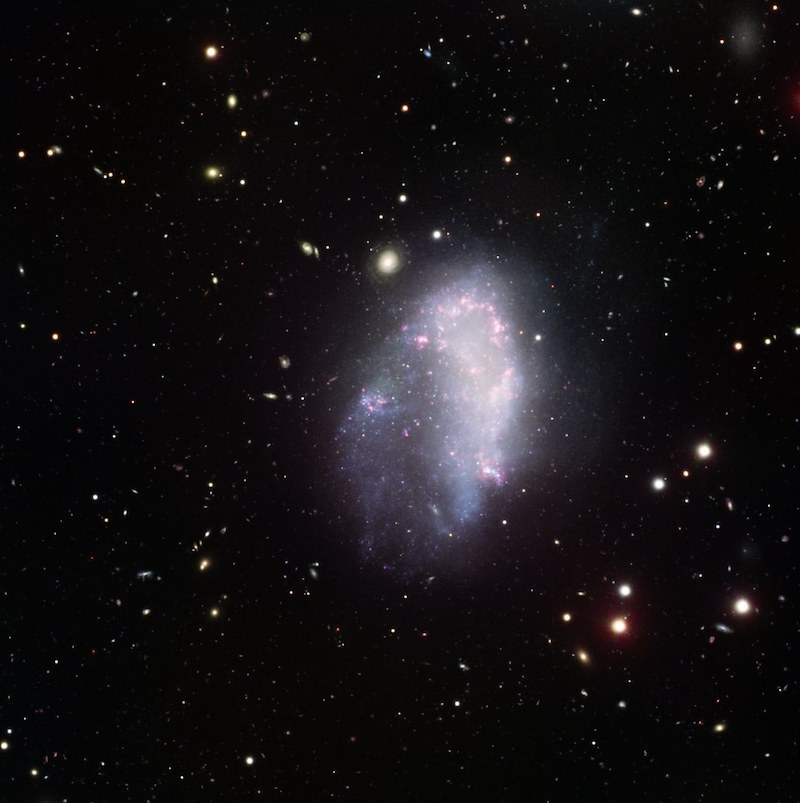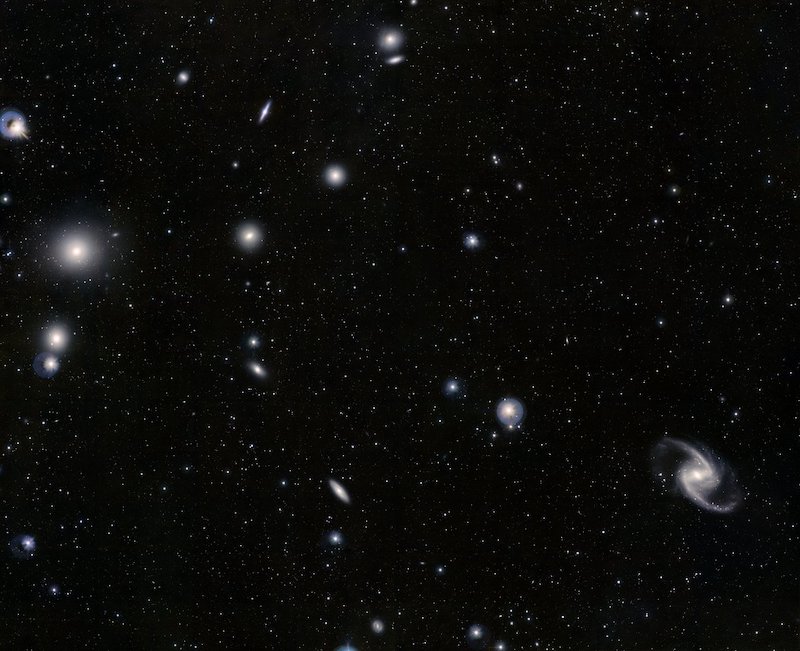
Galaxies are islands of stars in the sea of space. But galaxies are more than just the stars we see. According to the Standard Model of cosmology – which explains many observed properties of our universe and suggests that a Big Bang created all matter, space and time – most galaxies should be surrounded by a halo of dark matter. The dark matter is invisible to our eyes, but detectable via its gravitational pull. From time to time, though, there’ve been attempts to replace the Standard Model with a different model. And now another new study – announced August 5, 2022 – challenges the view of the universe presented by the Standard Model. The study is based on an analysis of dwarf galaxies in the Fornax Cluster, the second-closest large galaxy cluster to our Milky Way. The Standard Model says these little galaxies should have dark matter halos. The observations show no trace of dark matter halos.
Scientists at the University of Bonn in Germany and the University of Saint Andrews in Scotland led the study. These researchers published their peer-reviewed findings in the Monthly Notices of the Royal Astronomical Society on June 25, 2022.
A free version of the paper is also available on the arXiv preprint server.
A tidal force acting between galaxies
So the Fornax Cluster is the second-closest large galaxy cluster to our Milky Way. And, like all galaxy clusters, it contains many dwarf galaxies, often captured in orbits around the cluster’s larger galaxies. Being smaller, these dwarf galaxies are susceptible to the gravitational pull of the larger galaxies. And so they are subject to gravitational “tides,” not dissimilar from ocean tides on Earth, caused by the pull of the moon and sun.
Consider that the moon pulls most strongly on the side of Earth that’s facing it. And it pulls less strongly on the side of Earth farthest from the moon. That’s why we have two tidal bulges on Earth, and two high tides (and two low tides) each day all over the planet (read more about Earth’s tidal bulges here).
Likewise, a larger galaxy exerts a differential tidal force across a dwarf galaxy. It pulls more strongly on the near side of the dwarf galaxy than on the far side. And these scientist studied these tidal forces in dwarf galaxies in order to draw their conclusions. As lead study author Elena Asencio of University of Bonn said:
We introduce an innovative way of testing the Standard Model based on how much dwarf galaxies are disturbed by gravitational ‘tides’ from nearby larger galaxies.
The dwarf galaxies didn’t look right
So these researchers noticed something odd about the dwarf galaxies in the Fornax Cluster. The little galaxies didn’t look as they should look, according to the Standard Model. They looked distorted. What was causing that? And could another model of the universe explain these observations better? According to Pavel Kroupa at the University of Bonn and Charles University in Prague:
Such perturbations in the Fornax dwarfs are not expected according to the Standard Model. This is because, according to the Standard Model, the dark matter halos of these dwarfs should partly shield them from tides raised by the cluster.
In other words, if dark matter surrounded these clusters, it should in part protect them from the pull of nearby larger galaxies. Yet these dwarf galaxies appeared unshielded in this way. They were visibly distorted.


What was seen
How did these researchers conduct their study? They analyzed the expected amount of disturbance in the little galaxies, in accordance with the Standard Model’s predictions. And then they compared those results with the observed level of disturbance in images taken by the VLT Survey Telescope of the European Southern Observatory. As Asencio stated:
The comparison showed that, if one wants to explain the observations in the Standard Model, the Fornax dwarfs should already be destroyed by gravity from the cluster center …
So the theory and the observations didn’t match.
An alternate model, MOND
The researchers said the observed disturbances can’t be explained using the Standard Model. So they repeated their analysis using an alternate model, called the Modified Newtonian dynamics (MOND). MOND is a hypothesis proposing a modification of Newton’s law of universal gravitation. It’s an alternate theory of the universe. Indranil Banik from the University of St. Andrews commented:
We were not sure that the dwarf galaxies would be able to survive the extreme environment of a galaxy cluster in MOND, due to the absence of protective dark matter halos in this model. But our results show a remarkable agreement between observations and the MOND expectations for the level of disturbance of the Fornax dwarfs.
Co-authors Aku Venhola from the University of Oulu in Finland and Steffen Mieske from ESO added:
It is exciting to see that the data we obtained with the VLT survey telescope allowed such a thorough test of cosmological models.

Where does this leave the Standard Model?
The Fornax dwarf galaxy study is the latest of multiple recent studies suggesting that the observed dynamics and evolution of some galaxies can be best explained if no dark matter surrounds them. Yet the Standard Model calls for dark matter around galaxies. Pavel Kroupa at the University of Bonn said:
The number of publications showing incompatibilities between observations and the dark matter paradigm just keeps increasing every year. It is time to start investing more resources into more promising theories.
Hongsheng Zhao from the University of St Andrews added:
Our results have major implications for fundamental physics. We expect to find more disturbed dwarfs in other clusters, a prediction which other teams should verify.
Last December, scientists reported finding six other galaxies that seem to be missing dark matter. Astronomers also found two other similar galaxies in 2019 as well.
If, in the future, researchers discover more galaxies lacking dark matter halos, astronomers may have to reconsider whether the Standard Model – with its Big Bang and dark matter framework for galaxy evolution – still is the best model describing our universe, and open up the possibility of other scenarios.
Bottom line: A new study suggests dwarf galaxies in the Fornax cluster lack dark matter halos. This finding is the latest in a series that challenges the cosmological Standard Model, the prevailing theory of our universe.
The post Dark matter halos missing in Fornax Cluster first appeared on EarthSky.
0 Commentaires